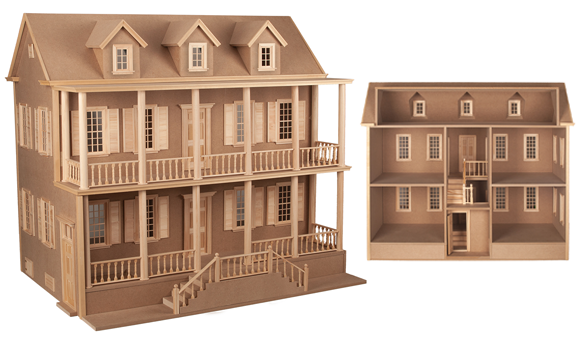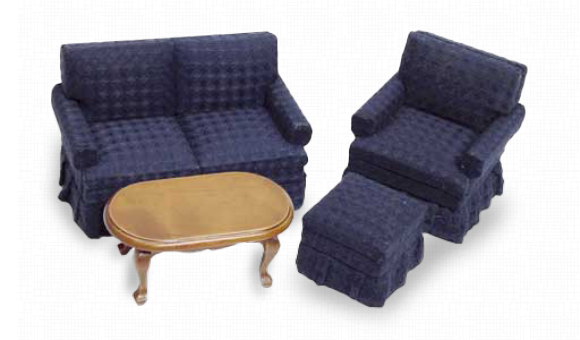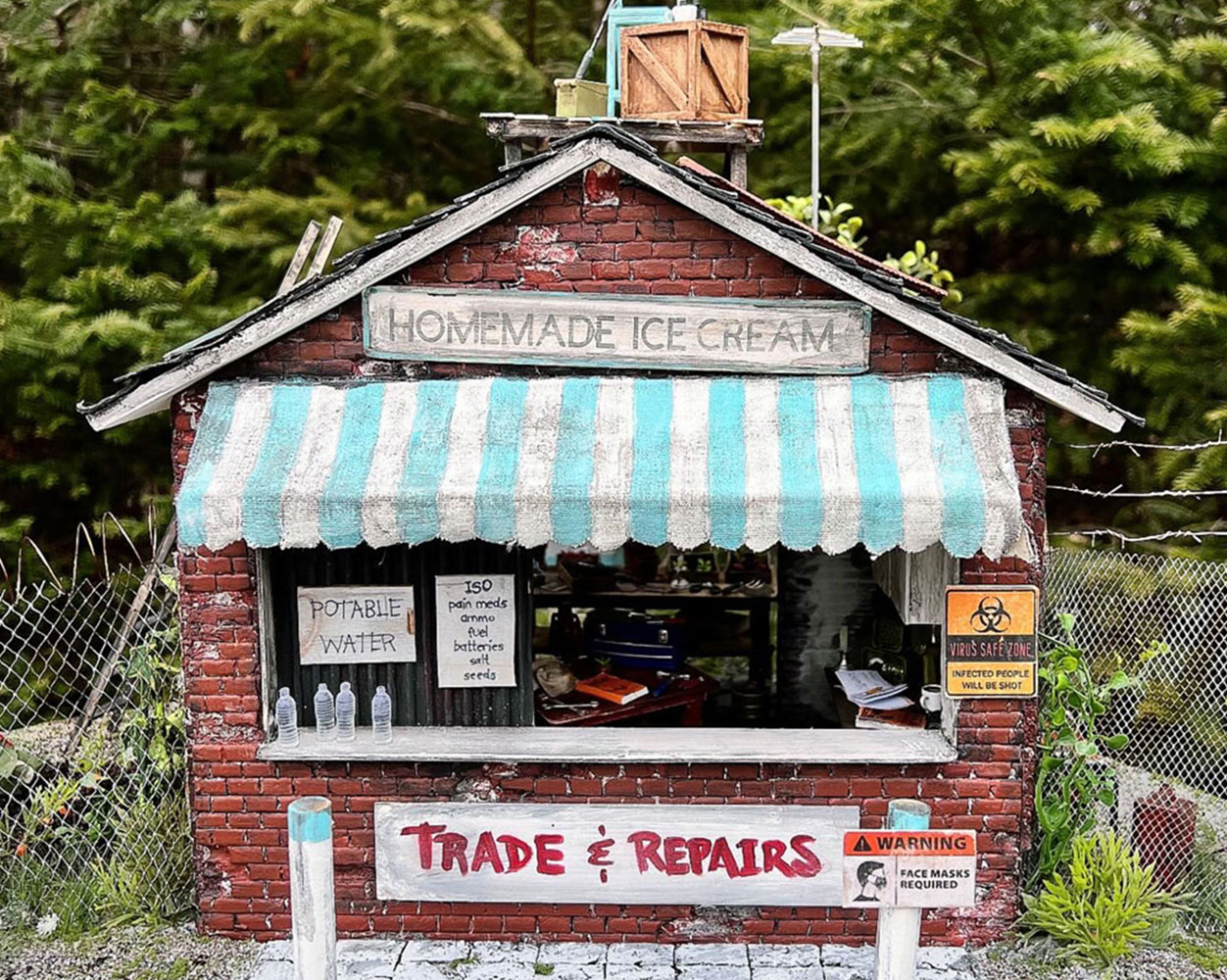by Fran Casselman

Materials:
#42331 Rustic Stacked Stone Wallpaper*
#2409 Outdoor Brick Fireplace
#97008 Ultimate Craft Knife
#600021 Self-Healing Cutting Mat
Fine-tooth small saw or serrated knife
Smooth, rigid foam blocks and sheets
Thin rigid foam with no paper surface (foam trays or disposable plates)
Lightweight spackling
Palette or putty knife
Dark gray Acrylic craft paint
“Stone” color Acrylic craft paint
Quilters’ pins (long, ball-head pins)
Fine-grit sanding block (optional)
Glue for paper**
White glue and glue-spreading tool
Pencil
Masking tape
Scrap paper
* #57710 Dolomite Stone Paper Panel would also be very effective for this project.
** I used rubber cement to adhere the paper to the MDF fireplace. When applied to both surfaces, rubber cement creates a very strong bond but it “grabs” very quickly so there is minimal working time. If using wallpaper paste or another water-based glue (white glue), apply sparingly and work quickly to avoid softening the spackling. Rubber cement and other non water-based glues, such as #74034 Multi-Grip or #59334 Quick Grip, will not soften the spackling.
Stone Patio
Base terrace
Determine the shape and size of your raised stone terrace. The height of this terrace was determined by the thickness of the material on hand and is 1 1/8" (28mm). Use a fine-tooth saw or serrated kitchen knife to cut the material to size, being careful to keep a vertical edge. If you need to assemble the base terrace from several smaller pieces, spread white glue generously on one surface and use quilters’ pins to hold the pieces together while the glue dries (it will take longer than usual because the foam is not absorbent). Weight the assembly to keep it flat, if necessary. To strengthen the joins, glue scrap paper over the “cracks,” including any at the edge. Be sure it is completely dry and remove any pins before moving on.
For steps, use a craft knife to carefully cut the waste area away.
Follow the same assembly procedure for any walls or raised seating. Do not attach any elements together at this point.
Cut strips of wallpaper to the height of the terrace base and apply with white glue spread onto the assembly, not the paper. Hold paper ends with masking tape (in areas that will not show) or quilters’ pins, if necessary. Let dry.
Cut through the paper in the center of the step area and along the step edge. Fold and glue the paper into the step area to cover the sides of the recess. Cover the back with a separate piece.
“Flagstone” top surface
With a craft knife on a cutting mat, cut the thin rigid foam into enough flat sections to cover the terrace and any walls or seats. Note: the “flagstone” extends a bit over the edge of the terrace base.
Find photos of terraces and patios to see how actual flagstones are laid. My terrace had a border pattern but the center was random. I chose to assemble the thin foam sections into a sheet large enough for the terrace, and then incorporate the joints into the random pattern drawn on the whole sheet. You could also cut individual “stones” to fit the spaces you have. Either way, use masking tape on the back to assemble the pieces into a sheet the size and shape of the terrace, making the joints as close as possible. Repeat for the step and the tops of any walls and seats.
Glue the assembled thin sheets to the base terrace and wall blocks, making sure the overhang is even. Put the assemblies upside down on the work surface and weight them while they dry. It will take longer than usual.
If you didn’t cut individual stones, use a blunt, rounded pencil point to sketch a pattern lightly on the surface of the terrace. Work with the joins you have and make random sizes and shapes until you have a pleasing pattern. Make some lines wavy and uneven for a more natural look. When you like what you have, go over the lines and press harder with the pencil to leave deep grooves in the foam. Try not to break the surface of the foam but do leave noticeable lines. If you did cut individual pieces, use the pencil to shape and delineate the stones.
If your terrace has attached walls or seats, don’t create or paint stones in the places where they will go.
Painting
There are no “rights” or “wrongs,” but remember not to rush and that less is generally better. You will need three similar variations (midtone base, noticeably lighter, noticeably darker) of whatever stone color you choose. The paper you use is a good place to start for color choices.
For technique, keep everything pretty wet. As needed, put blobs of paint on your palette (disposable plates work well) and keep a jar of water handy to rinse your brush.
Using the darkest color, paint over the pencil lines. You do not have to be too even or precise but try not to widen the lines a great deal. Remember to show joints in the edges. Next, with the midtone, paint all the stones individually with the paint thicker in some areas and more diluted in others. Sometimes the center of a stone will be paler; sometimes the color will shade from light to dark across the stone. Just play with it until every stone is painted but you see differences in each one. Remember the edges.
You could stop now, but it won’t take much more to really punch it up.
Make a very thin wash with the lightest color and paint over a few individual stones. It will look different where the base paint was heavier and lighter, or you can add color to only part of a stone. Don’t do too many, but try to choose random stones across the whole terrace.
Do the same using the dark color: very thin wash, uneven application, random overall placement.
Add a tiny bit of dark to the light wash and color a few more stones. Pause every now and then to look at the effect. When you see a pleasing overall appearance, stop! Resist the urge to “do something” to every stone. It’s easy to add later if you really want, but difficult to undo too much.
The surface of the foam is not absorbent, which makes it easy to move the color around and get nice effects with very thin paint applications but it does increase the drying time. Even after it feels dry to the touch, the paint surface may be fragile so try not to scratch it.
Tip: to help water-based paints adhere to smooth, non-absorbent surfaces, add a bit of soap. A drop of liquid detergent on the palette is plenty, or swipe your brush over a bar of soap every few strokes.
If your terrace has attached walls or seats, glue the parts together, weight if possible and secure with quilters’ pins until dry.
“Stone” Fireplace
Preparation
The fireplace unit is made of MDF, with grout lines milled into the surface to create the look and texture of the brick. The wallpaper is heavy and can cover uneven surfaces, but to be certain the brick pattern would not show through I used lightweight spackling to fill in the grooves, applying and smoothing away the excess with the palette knife/putty knife. When dry, sand lightly if needed.
Note: The resulting smooth surface was exactly what I wanted, but I realized this method could also work for an easy traditional brick finish. Just paint the fireplace in the preferred brick color(s) before applying the spackling, which can be tinted with “mortar”-colored paint if desired.
Method
Cut strips of wallpaper to the widths needed for the main “flat” areas of the fireplace: 1 3/8" (35mm) for the base, 3 3/16" (81mm) for the main/firebox section and 1 7/16" (31mm) for the chimney. Cut a strip 1 3/8" (or use scrap from the base strip) for the sloping sides of the chimney base; 1" (26mm) for the sloping front area. I did not cover the back of the fireplace and was able to use scrap paper for the smaller areas.
Working carefully, apply glue to the fireplace, not the paper, and cover each section separately. The base and chimney are simple shapes; work from the center out and crease the paper for crisp corners. The firebox area is a bit more complicated but not unlike papering a wall with a window opening. Slit the center from the bottom up to the height of the firebox opening, then start fitting the paper over the arch and use a craft knife to trim and fit as needed. At the opening, wrap the paper around to the inside for a finished look. Trim as needed.
Apply paper to the side areas of the sloped chimney base and wrap a bit over onto the front. Let dry before moving on to the front area. Treat the front slope as one flat area; let the ends hang over while the glue dries completely. Trim carefully with the craft knife. Color the cut edges with a pencil, markers or matching paint.
The “stone” areas may be painted before or after papering. Over a midtone base coat, use a pencil to draw lines indicating joints between stones and shade with diluted lighter and darker colors for interest. Paint the firebox several shades of gray, not black, for a realistic look.



